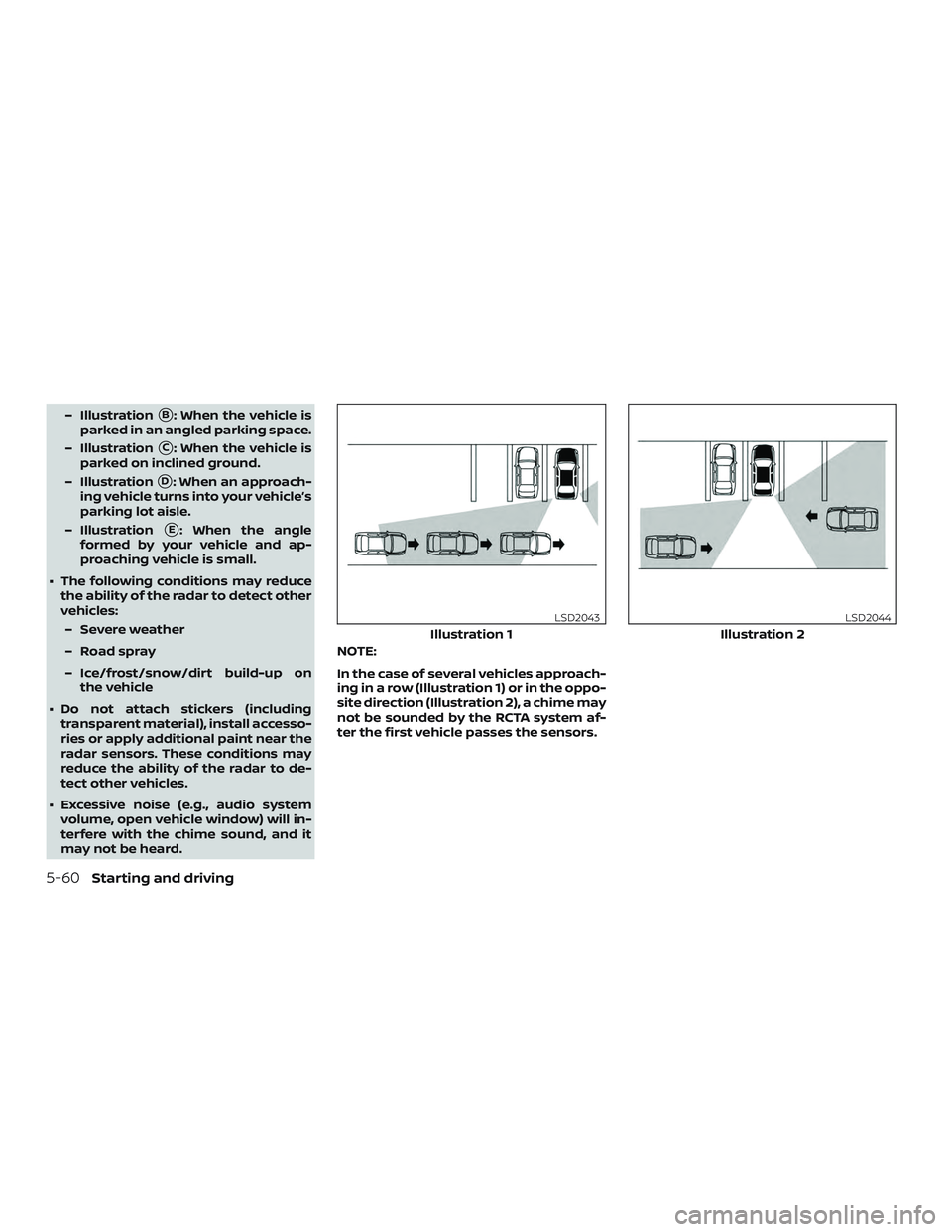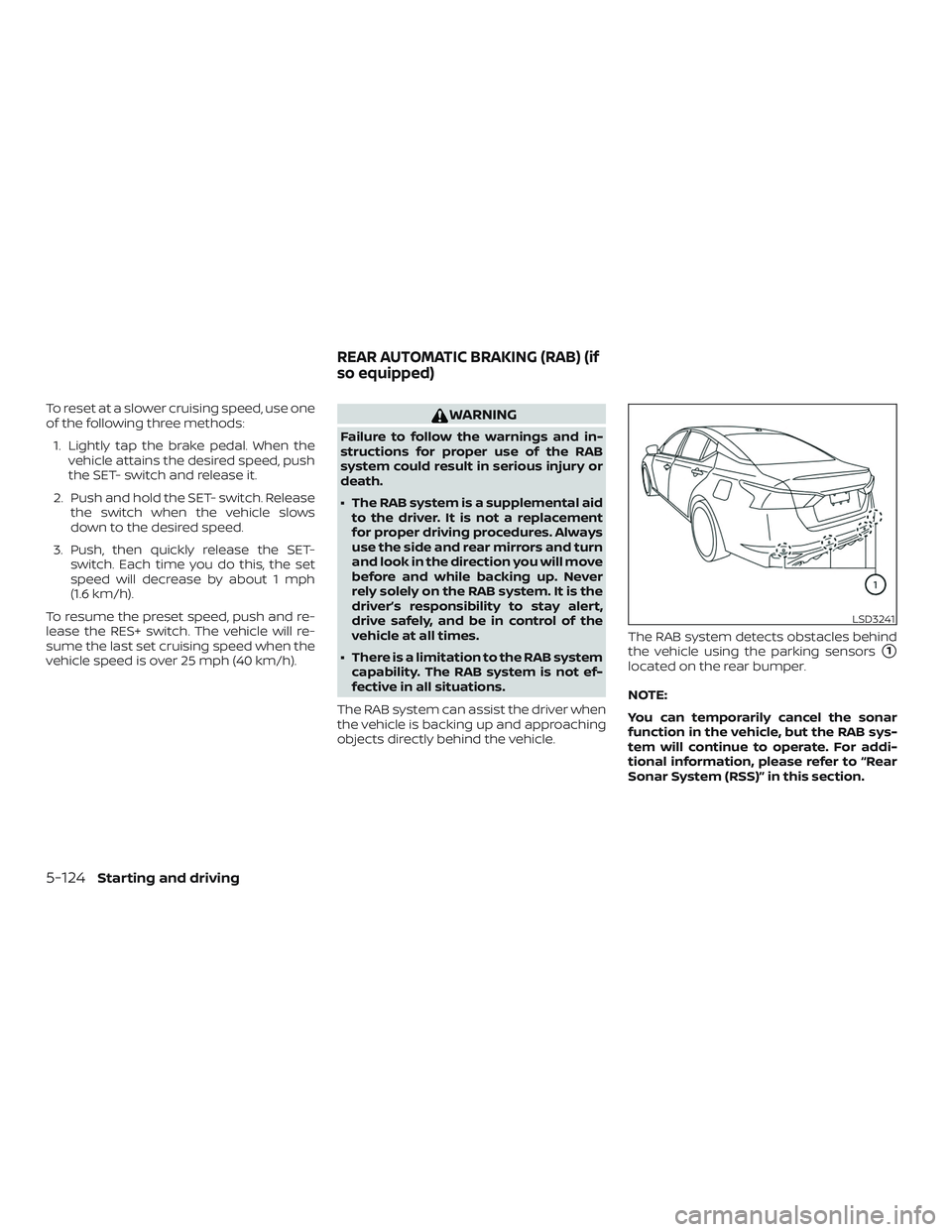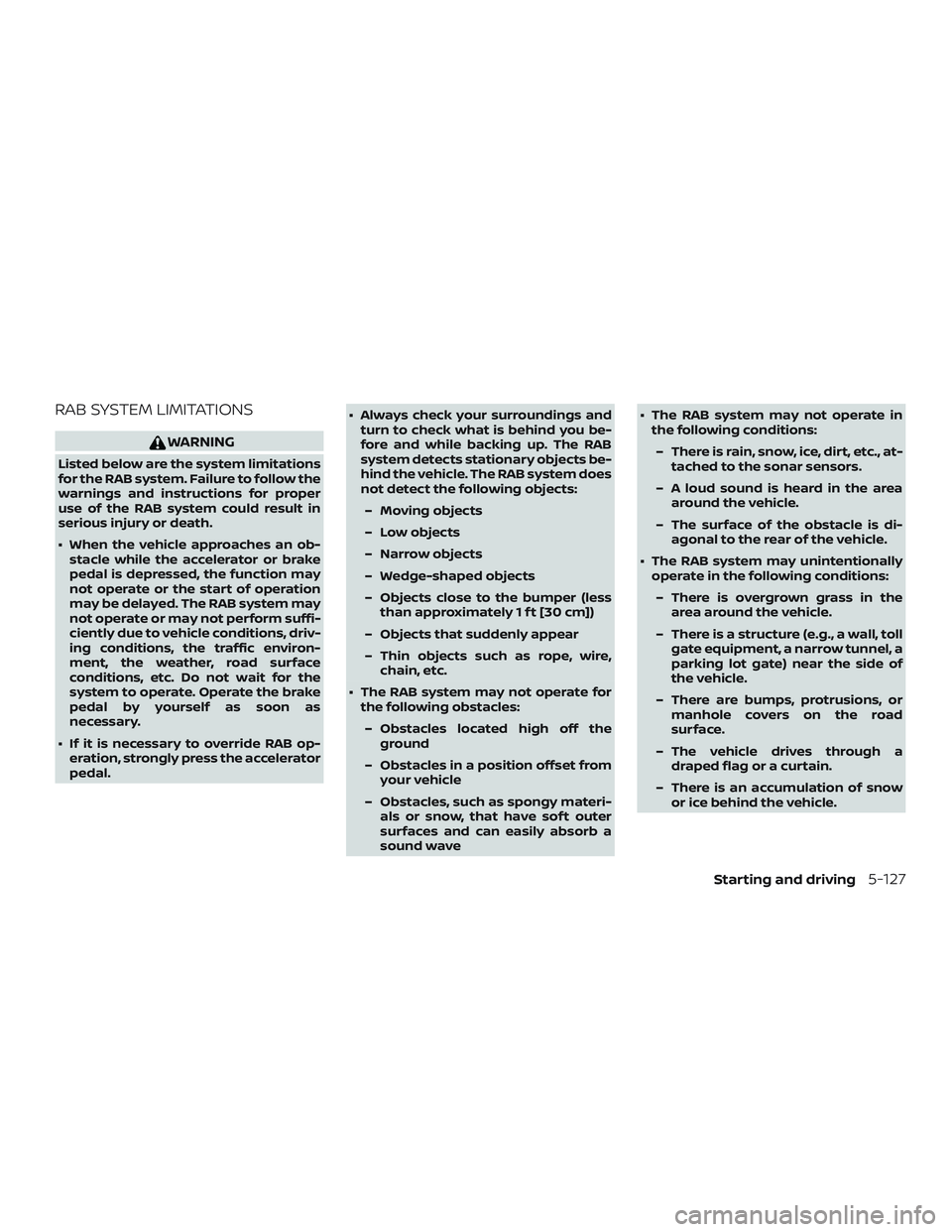Page 307 of 559

– Illustration�B: When the vehicle is
parked in an angled parking space.
– Illustration
�C: When the vehicle is
parked on inclined ground.
– Illustration
�D: When an approach-
ing vehicle turns into your vehicle’s
parking lot aisle.
– Illustration
�E: When the angle
formed by your vehicle and ap-
proaching vehicle is small.
∙ The following conditions may reduce the ability of the radar to detect other
vehicles:
– Severe weather
– Road spray
– Ice/frost/snow/dirt build-up on the vehicle
∙ Do not attach stickers (including transparent material), install accesso-
ries or apply additional paint near the
radar sensors. These conditions may
reduce the ability of the radar to de-
tect other vehicles.
∙ Excessive noise (e.g., audio system volume, open vehicle window) will in-
terfere with the chime sound, and it
may not be heard. NOTE:
In the case of several vehicles approach-
ing in a row (Illustration 1) or in the oppo-
site direction (Illustration 2), a chime may
not be sounded by the RCTA system af-
ter the first vehicle passes the sensors.
Illustration 1
LSD2043
Illustration 2
LSD2044
5-60Starting and driving
Page 371 of 559

To reset at a slower cruising speed, use one
of the following three methods:1. Lightly tap the brake pedal. When the vehicle attains the desired speed, push
the SET- switch and release it.
2. Push and hold the SET- switch. Release the switch when the vehicle slows
down to the desired speed.
3. Push, then quickly release the SET- switch. Each time you do this, the set
speed will decrease by about 1 mph
(1.6 km/h).
To resume the preset speed, push and re-
lease the RES+ switch. The vehicle will re-
sume the last set cruising speed when the
vehicle speed is over 25 mph (40 km/h).WARNING
Failure to follow the warnings and in-
structions for proper use of the RAB
system could result in serious injury or
death.
∙ The RAB system is a supplemental aid to the driver. It is not a replacement
for proper driving procedures. Always
use the side and rear mirrors and turn
and look in the direction you will move
before and while backing up. Never
rely solely on the RAB system. It is the
driver’s responsibility to stay alert,
drive safely, and be in control of the
vehicle at all times.
∙ There is a limitation to the RAB system capability. The RAB system is not ef-
fective in all situations.
The RAB system can assist the driver when
the vehicle is backing up and approaching
objects directly behind the vehicle. The RAB system detects obstacles behind
the vehicle using the parking sensors
�1
located on the rear bumper.
NOTE:
You can temporarily cancel the sonar
function in the vehicle, but the RAB sys-
tem will continue to operate. For addi-
tional information, please refer to “Rear
Sonar System (RSS)” in this section.
LSD3241
REAR AUTOMATIC BRAKING (RAB) (if
so equipped)
5-124Starting and driving
Page 374 of 559

RAB SYSTEM LIMITATIONS
WARNING
Listed below are the system limitations
for the RAB system. Failure to follow the
warnings and instructions for proper
use of the RAB system could result in
serious injury or death.
∙ When the vehicle approaches an ob-stacle while the accelerator or brake
pedal is depressed, the function may
not operate or the start of operation
may be delayed. The RAB system may
not operate or may not perform suffi-
ciently due to vehicle conditions, driv-
ing conditions, the traffic environ-
ment, the weather, road surface
conditions, etc. Do not wait for the
system to operate. Operate the brake
pedal by yourself as soon as
necessary.
∙ If it is necessary to override RAB op- eration, strongly press the accelerator
pedal. ∙ Always check your surroundings and
turn to check what is behind you be-
fore and while backing up. The RAB
system detects stationary objects be-
hind the vehicle. The RAB system does
not detect the following objects:
– Moving objects
– Low objects
– Narrow objects
– Wedge-shaped objects
– Objects close to the bumper (less than approximately 1 f t [30 cm])
– Objects that suddenly appear
– Thin objects such as rope, wire, chain, etc.
∙ The RAB system may not operate for the following obstacles:
– Obstacles located high off the ground
– Obstacles in a position offset from your vehicle
– Obstacles, such as spongy materi- als or snow, that have sof t outer
surfaces and can easily absorb a
sound wave ∙ The RAB system may not operate in
the following conditions:
– There is rain, snow, ice, dirt, etc., at- tached to the sonar sensors.
– A loud sound is heard in the area around the vehicle.
– The surface of the obstacle is di- agonal to the rear of the vehicle.
∙ The RAB system may unintentionally operate in the following conditions:
– There is overgrown grass in the area around the vehicle.
– There is a structure (e.g., a wall, toll gate equipment, a narrow tunnel, a
parking lot gate) near the side of
the vehicle.
– There are bumps, protrusions, or manhole covers on the road
surface.
– The vehicle drives through a draped flag or a curtain.
– There is an accumulation of snow or ice behind the vehicle.
Starting and driving5-127
Page 376 of 559
NOTE:
If the RAB system cannot be operated
temporarily, the RAB system warning
light blinks.
SYSTEM MAINTENANCE
Observe the following items to ensure
proper operation of the system:∙ Always keep the parking sensors
�1
clean.
∙ If the parking sensors are dirty, wipe them off with a sof t cloth while being
careful to not damage them. ∙ Do not subject the area around the
parking sensors
�1to strong impact.
Also, do not remove or disassemble the
parking sensors. If the parking sensors
and peripheral areas are deformed in
an accident, etc., have the sensors
checked. It is recommended that you
visit a NISSAN dealer for this service.
∙ Do not install any stickers (including transparent stickers) or accessories on
the parking sensors
�1and their sur-
rounding areas. This may cause a mal-
function or improper operation.
LSD3241
Starting and driving5-129